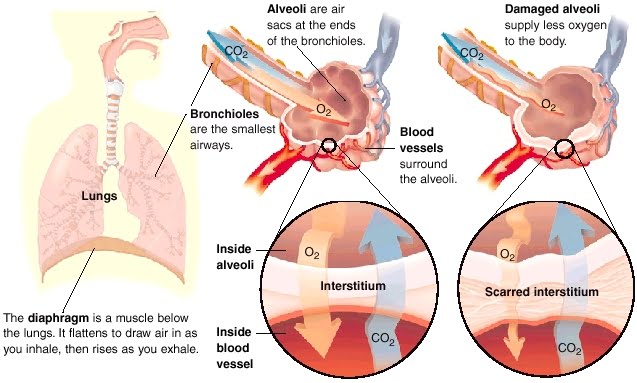An Interstitial Lung Disease is a large group of disorders and most of them can cause progressive scarring of lung tissue. The scarring which is associated with Interstitial lung disease will eventually affect your ability to breathe and you will get enough oxygen into your bloodstream.
Interstitial lung disease can be caused by the long – term exposure to hazardous materials, such as asbestos [1]. Also, some types of autoimmune diseases, like rheumatoid arthritis, can cause interstitial lung disease. Also, there are some cases when the cause of interstitial lung disease is not known.

When lung scarring happens, then it is generally irreversible. Medications can slow the damage of interstitial lung disease, but there are many people who never regain the full usage of their lungs. A lung transplant is an option for some people who suffer from interstitial lung disease.
Symptoms
Contents
The primary signs and symptoms of interstitial lung disease [2] are including:
- Dry cough
- The shortness of breath at rest or aggravated by exertion
But, many cases of interstitial lung disease have already occurred by the time symptoms appear. But, it is very important to see your doctor at the first sign of breathing problems. There are many other conditions other than interstitial lung disease that can affect your lungs, but getting an early and accurate diagnosis of this condition is very important for the proper treatment.
Causes
Interstitial lung disease happens when the injury to your lungs triggers an abnormal healing response. In some cases, your body generates just the right amount of tissue to repair this damage. But, in people who suffer from interstitial lung disease, the repair process goes away and the tissue around the air sacs (called alveoli) becomes scarred and thickened.
This is making it more difficult for oxygen to pass into your bloodstream. There are many different things that can trigger interstitial lung diseases, such as some types of medical treatments, drugs, and airborne toxins in the workplace. There are some cases when causes for interstitial lung disease are not known.
1. Occupation and Environmental Factors
The long–term exposure to a number of toxins and pollutants can damage your lungs and they include:
- Indoor hot tubs
- Radiation treatments [3]
- Bird and animal droppings [4]
- Grain dust
- Asbestos fibers [1]
- Silica dust
There are some people who receive radiation therapy for breast or lung cancers and they show signs of lung damage months or sometimes years after the initial treatment.
2. Medications
There are many drugs that can damage your lungs [5], such as:
- Anti-inflammatory drugs
- Some antibiotics
- Heart medications
- Chemotherapy drugs
3. Medical conditions
Lung damage can result from autoimmune diseases, such as:
- Sarcoidosis
- Rheumatoid arthritis [6]
- Sjorgen’s syndrome
- Scleroderma [7]
- Mixed connective tissue disease
- Dermatomyositis and polymyositis
Risk Factors
There are some factors that can increase your risk of interstitial lung disease, such as
1. Radiation and Chemotherapy
If you have radiation treatments to your chest or you use some chemotherapy drugs, then this will increase your risk of developing interstitial lung disease. [3]
2. Age
Interstitial lung disease is more likely to happen in adults, but infants and children sometimes can develop it too.
3. Smoking
It is noticed that some forms of interstitial lung disease are more likely to happen in people who have a history of smoking and active smoking can make this condition worse, especially if it is associated with emphysema. [8]
4. Exposure to Occupation and Environmental Toxins
Your risk of interstitial lung disease is increased if you work in construction, farming, or mining, or for any reason, you are exposed to pollutants. [1]
5. Gastroesophageal Reflux Disease
If you have uncontrolled acid reflux or indigestion, then your risk for interstitial lung disease is increased. [9]
Complications
Interstitial lung disease can lead to a series of life-threatening complications, such as
- Respiratory failure
- High blood pressure in your lungs, which is known as pulmonary hypertension
- Right-sided heart failure, which is known as cor pulmonale
References:
[1] Kamp DW. Asbestos-induced lung diseases: an update. Translational Research. 2009;153(4):143–52. doi:10.1016/j.trsl.2009.01.004
[2] American Lung Association. Interstitial lung disease (ILD). Retrieved from www.lung.org/lung-health-diseases/lung-disease-lookup/interstitial-lung-disease
[3] Goodman CD, Nijman SFM, Senan S, et al. A primer on interstitial lung disease and thoracic radiation. Journal of Thoracic Oncology. 2020;15(6):902-13.
[4] May S, Romberger DJ, Poole JA. Respiratory health effects of large animal farming environments. Journal of Toxicology and Environmental Health. 2012;15(8):524–41.
doi:10.1080/10937404.2012.744288
[5] Schwaiblmair M, Behr W, Haeckel T, et al. Drug-induced interstitial lung disease. The Open Respiratory Medicine Journal. 2012;6:63–74. doi:10.2174/1874306401206010063
[6] Cano-Jiménez E, Vázquez Rodríguez T, Martín-Robles I, et al. Diagnostic delay of associated interstitial lung disease increases mortality in rheumatoid arthritis. Scientific Reports. 2021;11.
[7] Cottin V, Brown KK. Interstitial lung disease associated with systemic sclerosis (SSc-ILD). Respiratory Research. 2019;20.
[8] Ryu JH, Colby TV, Hartman TE, Vassallo R. Smoking-related interstitial lung diseases: a concise review. European Respiratory Journal. 2001;17:122-32.
[9] Soares RV, Forsythe A, Hogarth K, et al. Interstitial lung disease and gastroesophageal reflux disease: key role of esophageal function tests in the diagnosis and treatment. Arquivos de Gastroenterologia. 2011;48(2).




